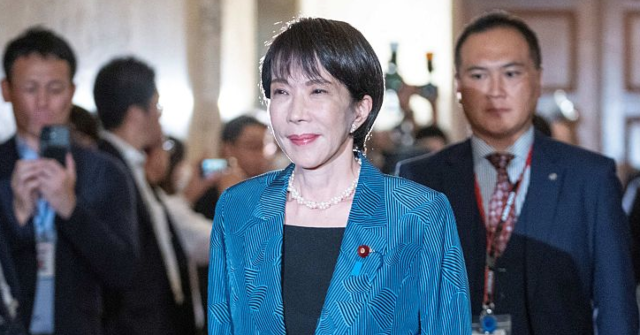Japan’s ruling Liberal Democratic Party (LDP) made a deal on Monday to form a coalition with the Japan Innovation Party, generally known as “Ishin,” that should clear away the final obstacles to conservative Takaichi Sanae becoming Japan’s first female prime minister.
Ishin leader Yoshimura Hirofumi admitted on Monday that forming a coalition with Takaichi’s party was a “very difficult decision” because most of the gigantic LDP’s previous partners have “disappeared.”
It was also a big step for Ishin members because the party was founded ten years ago in Osaka, where Yoshimura is the mayor, largely to oppose the dominant LDP on certain key issues, and perhaps eventually replace it.
Ishin is currently the third-largest party in the National Diet, the Japanese parliament. The new coalition will hold 231 seats in the lower house of the Diet — leaving it two seats shy of an absolute majority, but almost certainly enough to ensure Takaichi becomes prime minister when the votes are cast on Tuesday.
The political stars aligned for LDP and Ishin (whose popular nickname means “renewal”) after LDP’s longtime coalition partner Komeito bolted two weeks ago. Komeito, a party with strong Buddhist religious ties, disagreed with Takaichi’s tough stance on immigration and had lingering concerns about a corruption scandal that has haunted LDP for the past few years.
LDP itself took a beating in the last few elections, due partly to the corruption scandal as well as the plummeting popularity of Prime Minister Ishiba Shigeru. LDP remains Japan’s largest party, as it has been throughout the postwar era, but it lost its majorities in both houses of the Diet.
Ishiba took responsibility for these losses and announced his resignation in September, triggering a leadership race that Takaichi narrowly won in early October. Japanese markets were euphoric over her victory, seeing her as a tough and charismatic populist conservative in the mold of Margaret Thatcher (her personal political heroine) and a disciple of the successful economic policies of her mentor, the late Abe Shinzo.
Takaichi’s political philosophy has also been compared to that of President Donald Trump, who was close friends with Abe, so Japan’s business community hoped Takaichi would be able to build a stronger relationship with the United States and resolve lingering trade issues. Becoming Japan’s first female PM would also be a landmark cultural moment.
Everything looked good for Takaichi after she notched her somewhat surprising victory in the LDP leadership race — except then Komeito dissolved its 26-year partnership with Takaichi’s party, and the chances that the opposition might be able to thwart her rise to the prime minister’s office increased.
LDP went shopping for a new partner and sealed the deal on Monday with Ishin — the party that might well have been able to scuttle Takaichi’s ambitions and toss LDP out of power for one of the few times since the end of World War II.
Ishin is currently in alignment with LDP and Takaichi on several key issues, including stronger national defense, reducing the number of seats in the legislature, and rewriting the pacifist Japanese constitution. They are both skeptical of mass migration, although Ishin takes a softer position on the issue than Takaichi does. Ishin lost some seats in the past legislative election to Sanseito, the party most strongly opposed to immigration.
Ishin is more liberal on social issues than LDP, but the biggest policy difference between the uneasy coalition partners at the moment is that Ishin is fiscally conservative, while Takaichi wants to increase social spending. Ishin also wants strong limits on political donations, including an outright ban on political spending by corporations, which is the heart of the corruption scandal that made so many voters — and the Komeito party — turn their backs on LDP.
An interesting development during coalition negotiations is that Ishin politely refused Takaichi’s offer of seats in her Cabinet, preferring an “advisory” role from outside the government. That could be Ishin’s way of maintaining distance from LDP, preserving its ties with other opposition parties, and keeping its options open if Takaichi’s administration is unsuccessful.
“My party will further advance the reforms we have been advocating. I think we share the same intention to improve Japan. I would like to work together to make Japan a country that children think of as a truly great place when they grow up,” Yoshimura said when announcing the coalition with LDP.
“Politics should be about taking risks when necessary to open up new paths,” he replied when asked about the risks of partnering with Takaichi.
One of Yoshimura’s reportedly non-negotiable demands was for the Japanese government to designate his city of Osaka as the backup capital, in the event a crisis or national disaster causes severe damage to Tokyo. Japan’s capital has relocated 42 times during its history, often due to natural disasters, so the idea of having a backup capital is not new.
If Takaichi wins the election on Tuesday as expected, she will have several eventful weeks ahead of her. President Trump is due to visit Japan before the end of the month, and the next Asia-Pacific Economic Cooperation (APEC) summit is scheduled for October 31.
Read the full article here


